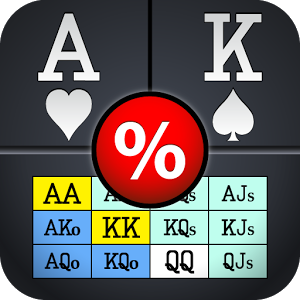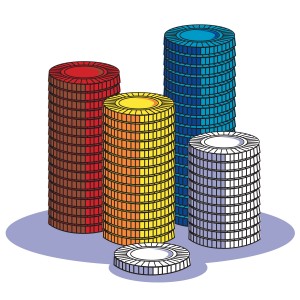This article will not tell you what is wrong with your game; there are plenty of resources out there to help you with that. This article will suggest ways that you can assess how important leaks are and prioritise accordingly.
How do you know where your biggest weaknesses are, and what leaks should you be concentrating on? If you find something in your game that you feel is costing you money, how do you know how much money it is costing you? Well, it is a simple matter of calculating:
a) How often the situation occurs (frequency) and
b) How much money you lose on average each time you do it (magnitude).
Multiply one by the other and you effectively have a measure of how important that leak is. For example, if you make a mistake twice every 100 hands and it costs you 0.3BB on average, then effectively this error is costing you 0.6BB/100, which is a comparatively huge leak. On the other hand, if you make a certain mistake only once every 1000 hands and only costs you 0.05BB on average then that mistake is only costing you 0.005BB/100, and fixing it will have only a tiny affect on your results, even in the long term.
When determining what leaks we should prioritise, we are really trying to find two things. Mistakes we make most often and the mistakes that cost us the most money.
Assessing Frequency
The first half of the equation is the easiest to measure. It is normally intuitive how often a particular situation occurs; in fact sometimes you may know the answer off the top of your head. For example, if your issue is with small pocket pairs, then you can say with certainly that you will be dealt 22-66 5 times every 221 hands on average (1 in 221 for each pair) or approximately 2% of all hands.
Other situations may be more difficult to determine how often they occur. For example, it would be difficult to calculate off the top of your head how often you are raised on the river when you hold top pair/top kicker and there is a 3-flush on the board. Poker tracker can be your friend here, as it can filter your hand database according to a number of criteria.
In order to properly assess leaks it is important to group them together as much as possible. For example, maybe you have identified that you play TT badly when an overcard falls on the flop and you have three opponents. On it’s own this is a low frequency leak, but if you have this problem the chances are you also have problems with two or four opponents, and with 88, 99 and JJ too. Collectively this is now a much higher frequency leak. Try to spot the difference between a leak and a situation. One leak may cause problems in a number of different situations.
The difference between a high-frequency leak and a low-frequency leak is naturally fairly arbitrary. For the purpose of the rest of this article I will consider any leak that causes an issue more than once every 100 hands is a high frequency leak, and anything less than once every 200 hands is low frequency. Between 1/100 and 1/200 you’ll have to consider it somewhere in between and act accordingly.
Assessing Magnitude
Measuring the magnitude of a leak is far more difficult than measuring the frequency. Remember we are trying to measure [i]on average[i] how much that error costs you. To do this we must account for the times you act correctly but lose and the times you act incorrectly and win.
For example, let’s say you are faced with a bet on the river and the pot (including that bet) is 8BB. You have junk but make a bad call to ‘look him up’ and your opponent wins the pot. On the face of it, this error costs you 1BB but does it really? What if your hand is actually best 5% of the time this situation occurs? 5% is a very small percentage and it would still be correct to fold, but calling is only costing you 0.6BB per hand on average, because of the 8BB you win that 5% of the time. If your hand is best 10% of the time, your bad call only costs 0.2BB per hand.
Without going too deeply into this, what is clear is that most errors in limit hold’em only cost you a fraction of a bet, and most cost a tiny fraction of a bet. Some refute this by saying that an error on one street actually costs a player a lot of bets over a number of streets. For example a player who calls with bottom pair on a multi-way flop may also call on the turn and river. However, this is not one error but three separate errors, each of which cost only a fraction of a bet.
Because it is so difficult to calculate how much an error costs you, it is difficult to put numbers on it for the purpose of the next section. Certainly anything that costs you over 0.25BB on average is a major error. Low magnitude errors tend to be the kind of things discussed on the ITH hand examples forum on a regular basis. They will generally be difficult to spot when playing in real time and are only noticed when analysing the hand later. Any error that costs you less than 0.1BB on average can almost certainly be considered a low magnitude error.
The Four Types of Leak
By putting frequency and magnitude into a 2 by 2 matrix, you effectively arrive at four different types of leak. Obviously, this pigeon holing is rather arbitrary and there will be considerable variation on both frequency and magnitude within each category. However, the purpose of this is to give you an idea of the way you should prioritise leaks and ultimately how damaging they might be.
High Frequency + High Magnitude = Major Weakness
These are the leaks that will really hurt you. If you have major weaknesses in your game you will struggle to be a winning player in the long term. These are the kind of leaks that poker books such as Internet Texas Hold’em attempt to eliminate. Examples might be cold-calling pre-flop raises with easily dominated hands, calling down turn raises with mediocre holdings and folding on the river too often. Anything in fact that you will have the opportunity to do quite often and will cost you heavily when you do.
Hopefully you have already eliminated all major weaknesses from your game, if not they need to be tackled immediately! Study hard to work out where you are going wrong, and then concentrate hard to improve these areas of your game. You are playing severely handicapped until you do.
Low Frequency + High Magnitude = Rookie Error
So called because they are mistakes commonly made by serious but inexperienced players. While the error can cost you a lot of money on average, the situation doesn’t occur too often. Examples might be calling pre-flop raises from tight players in early position with AQ or betting the river out of position when your opponent appears to be on a draw and a card falls that may fill that draw. These individual leaks won’t cost you huge amounts because they won’t occur too frequently. However, they are very difficult to detect because they don’t happen often enough for you to really observe a pattern. If you are making a lot of rookie errors, they can collectively have a big impact on your win rate without you really noticing.
Rookie errors tend to fall into the ‘easy to fix, hard to find’ category. Treat them as a high priority especially if you are fairly new to the game, as you will get a good reward for comparatively little effort. The best way to identify rookie errors is to post plenty of hand examples on the forum, where more experienced players might flag them for your attention. This is generally more effective than studying your own results where you will rarely have enough data to draw any meaningful conclusions.
High Frequency + Low Magnitude = Subtle Leak
Subtle leaks are the bane of the poker player’s life. They will slowly erode your win-rate, small amount by small amount. They can be difficult to correct because the error will often be so small it is difficult to measure without a large database of results. Examples are incorrectly counting outs, playing slightly loose pre-flop and calling too often on the flop. Eliminating these leaks can be extremely difficult because they often come down to very subtle distinctions that even good players may disagree on.
Plugging these leaks is important, but you may want to work on rookie errors first as these will give you a better reward/effort ratio. While eliminating subtle leaks completely can be difficult, the important thing is to keep chipping away at them. For example if you are making too many loose calls on the flop, try to eliminate the loosest of these, and then the next loosest and so on. By doing this you will slowly lower the frequency of your subtle leaks and maybe also the magnitude, as the errors costing you the most money are normally easiest to spot.
Low Frequency + Low Magnitude = Obscure Technicality
These leaks are really not that important. It is a mistake you make rarely and when you make it, it doesn’t cost you too much money. There can be a problem identifying these leaks at all because it is very difficult to collect enough data to get a conclusive result. These leaks should be treated as the lowest priority when improving your game.
Unfortunately many poker players are fixated by them. They will have endless debates about whether it is better to cap a re-raise with QQ or merely call. They will make posts every time they flop a full house, worrying that by playing it slightly differently they could have extracted more money. These are not the issues these players need to be focussing on!
Because these errors are so small, often there isn’t even a consensus as to what the best play is. Ask an accomplished player whether you should cap or just call a re-raise with QQ pre-flop against an unknown player, and you may get an opinion (which could go either way), but most likely you will get something along the lines of ‘I do it this way but it doesn’t really matter’, ‘either is fine’ or ‘I will mix up my play and do both’. If you are worrying about plays like this your game is either so good you can afford to or (far more likely) you are focussing on the wrong thing.
Conclusion
While making any effort to improve your game is commendable, it is far better to focus on those areas that are likely to yield the best results in monetary terms. When confronted with a potential leak, ask yourself how much the error is costing you and how often you make it. If the answer to both questions is ‘not a lot’ don’t be afraid to put the issue on the back burner for the time being. Find and eliminate the mistakes that you make most often or that cost you the most money to get better results faster.
Submit your review | |











